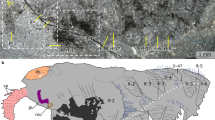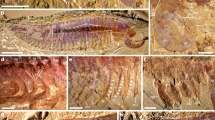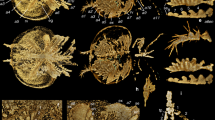Abstract
The organization of the head provides critical data for resolving the phylogenetic relationships and evolutionary history of extinct and extant euarthropods1,2. The early Cambrian-period fuxianhuiids are regarded as basal representatives of stem-group Euarthropoda3,4,5,6,7, and their anterior morphology therefore offers key insights for reconstructing the ancestral condition of the euarthropod head1,2,3,8,9,10,11. However, the paired post-antennal structures in Fuxianhuia protensa remain controversial3,8,10; they have been interpreted as both ‘great appendages’1,2 and as gut diverticulae4,12,13. Here we describe Chengjiangocaris kunmingensis sp. nov. and Fuxianhuia xiaoshibaensis sp. nov. from a new early Cambrian (Stage 3) fossil Lagerstätte in Yunnan, China. Numerous specimens of both species show a unique ‘taphonomic dissection’ of the anterodorsal head shield, revealing the cephalic organization in detail. We demonstrate the presence of a pair of specialized post-antennal appendages (SPAs) in the fuxianhuiid head, which attach at either side of the posteriorly directed mouth, behind the hypostome. Preserved functional articulations indicate a well-defined but restricted range of limb movement, suggestive of a simple type of sweep feeding. The organization of the SPAs in fuxianhuiids is incompatible with the (deutocerebral) anterior raptorial appendages of megacheirans2,9,14,15, and argue against the presence of protocerebral limbs in the fuxianhuiids1,2,9. The positions of the fuxianhuiid antennae and SPAs indicate that they are segmentally homologous to the deutocerebral and tritocerebral appendages of crown-group Euarthropoda respectively2,11,16,17. These findings indicate that antenniform deutocerebral appendages with many podomeres are a plesiomorphic feature of the ancestral euarthropod head.
This is a preview of subscription content, access via your institution
Access options
Subscribe to this journal
Receive 51 print issues and online access
$199.00 per year
only $3.90 per issue
Buy this article
- Purchase on Springer Link
- Instant access to full article PDF
Prices may be subject to local taxes which are calculated during checkout



Similar content being viewed by others
References
Budd, G. E. A palaeontological solution to the arthropod head problem. Nature 417, 271–275 (2002)
Scholtz, G. & Edgecombe, G. D. The evolution of arthropod heads: reconciling morphological, developmental and palaeontological evidence. Dev. Genes Evol. 216, 395–415 (2006)
Chen, J.-Y., Edgecombe, G. D., Ramsköld, L. & Zhou, G.-Q. Head segmentation in early Cambrian Fuxianhuia: implications for arthropod evolution. Science 268, 1339–1343 (1995)
Waloszek, D., Chen, J., Maas, A. & Wang, W. Early Cambrian arthropods—new insights into arthropod head and structural evolution. Arthropod Struct. Dev. 34, 189–205 (2005)
Waloszek, D., Maas, A., Chen, J. & Stein, M. Evolution of cephalic feeding structures and the phylogeny of Arthropoda. Palaeogeogr. Palaeoclimatol. Palaeoecol. 254, 273–287 (2007)
Daley, A. C., Budd, G. E., Caron, J.-B., Edgecombe, G. D. & Collins, D. The Burgess Shale anomalocaridid Hurdia and its significance for early euarthropod evolution. Science 323, 1597–1600 (2009)
Budd, G. E. & Telford, M. J. The origin and evolution of arthropods. Nature 457, 812–817 (2009)
Hou, X.-G. & Bergström, J. Arthropods of the Lower Cambrian Chengjiang fauna, southwest China. Fossils and Strata, No. 45, 1–116 (Wiley, 1997)
Scholtz, G. & Edgecombe, G. D. In Crustacea and Arthropod Relationships (Crustacean Issues) (eds Koenemann, S. & Jenner, R.A.) 139–165 (CRC Press, 2005)
Budd, G. E. Head structure in upper stem-group euarthropods. Palaeontology 51, 561–573 (2008)
Ma, X., Hou, X.-G., Edgecombe, G. D. & Strausfeld, N. J. Complex brain and optic lobes in an early Cambrian arthropod. Nature 490, 258–261 (2012)
Bergström, J., Hou, X. G., Zhang, X.-G., Liu, Y. & Clausen, S. A new view of the Cambrian arthropod Fuxianhuia. Geologiska Föreningen 130, 189–201 (2008)
Stein, M. A new arthropod from the Early Cambrian of North Greenland, with a ‘great appendage’-like antennula. Zool. J. Linn. Soc. 158, 477–500 (2010)
Chen, J.-Y., Waloszek, D. & Maas, A. A new ‘great-appendage’ arthropod from the Lower Cambrian of China and homology of chelicerate chelicerae and raptorial antero-ventral appendages. Lethaia 15, 3–20 (2004)
Haug, J. T., Waloszek, D., Maas, A., Liu, Y. & Haug, C. Functional morphology, ontogeny and evolution of mantis shrimp-like predators in the Cambrian. Palaeontology 55, 369–399 (2012)
Mittmann, B. & Scholtz, G. Development of the nervous system in the “head” of Limulus polyphemus (Chelicerata, Xiphosura): morphological evidence for a correspondence between the segments of the chelicerae and of the (first) antennae of Mandibulata. Dev. Genes Evol. 213, 9–17 (2003)
Harzsch, S., Wildt, M., Battelle, B. & Waloszek, D. Immunohistochemical localization of neurotransmitters in the nervous system of larval Limulus polyphemus (Chelicerata, Xiphosura): evidence for a conserved protocerebral architecture in Euarthropoda. Arthropod Struct. Dev. 34, 327–342 (2005)
Eriksson, B. J., Tait, N. N., Budd, G. E., Janssen, R. & Akam, M. Head patterning and Hox gene expression in an onychophoran and its implications for the arthropod head problem. Dev. Genes Evol. 220, 117–122 (2010)
Liu, J. et al. An armoured Cambrian lobopodian from China with arthropod-like appendages. Nature 470, 526–530 (2011)
Hou, X. G. et al. The Cambrian Fossils of Chengjiang, China: the Flowering of Early Animal Life (Blackwell Publishing, 2004)
Harzsch, S. & Waloszek, D. Serotonin-immunoreactive neurons in the ventral nerve cord of Crustacea: a character to study aspects of arthropod phylogeny. Arthropod Struct. Dev. 29, 307–322 (2000)
Olesen, J. Phylogeny of Branchiopoda (Crustacea)—character evolution and contribution of uniquely preserved fossil. Arthropod Syst. Phyl. 67, 3–39 (2009)
Liu, Y., Maas, A. & Waloszek, D. Early development of the anterior body region of the grey widow spider Latrodectus geometricus Koch, 1841 (Theridiidae, Araneae). Arthropod Struct. Dev. 38, 401–416 (2009)
Liu, Y., Maas, A. & Waloszek, D. Early development of the head region of Gryllus assimilis Fabricius, 1775 (Orthopera, Insecta). Arthropod Struct. Dev. 39, 382–395 (2010)
Popadíc, A., Panganiban, D. R., Shear, W. A. & Kaufman, T. C. Molecular evidence for the gnathobasic derivation of arthropod mandibles and for the appendicular origin of the labrum and other structures. Dev. Genes Evol. 208, 142–150 (1998)
Posnien, N. F., Bashasab, F. & Bucher, G. The insect upper lip (labrum) is a non-segmental appendage-like structure. Evol. Dev. 11, 440–488 (2009)
Bitsch, J. & Bitsch, C. The tritocerebrum and the clypeolabrum in mandibulate arthropods: segmental interpretation. Acta Zool. 91, 249–266 (2010)
Steinmetz, P. R. H. et al. Six3 demarcates the anterior-most developing brain region in bilaterian animals. Evodevo 1, 14 (2010)
Legg, D. A., Sutton, M. D., Edgecombe, G. D. & Caron, J.-B. Cambrian bivalved arthropod reveals origin of arthrodization. Proc. R. Soc. B 279, 4699–4704 (2012)
Acknowledgements
This study is supported by the National Natural Science Foundation of China (41272027), and the PhD Fund of the Ministry of Education of China (20115301110005). J.O.-H. is funded by CONACYT (Consejo Nacional de Ciencia y Tecnología, México), the University of Cambridge Trusts and Darwin College, University of Cambridge. We thank C. Shen, T. Lan and J.-B Hou for assistance in the field.
Author information
Authors and Affiliations
Contributions
Author Contributions The LSID urn:lsid:zoobank.org:pub:B3E00449-6531-4B15-9A36-411C10F1B466 has been deposited in ZooBank. J.Y. discovered the fossil localities, and collected and prepared all the material. J.O.-H. wrote the manuscript with input from the other authors. N.J.B. and X.-g.Z. designed the research.
Corresponding author
Ethics declarations
Competing interests
The authors declare no competing financial interests.
Supplementary information
Supplementary Information
This file contains Supplementary Figures 1-4, Supplementary Table 1 and Supplementary References. (PDF 4682 kb)
Rights and permissions
About this article
Cite this article
Yang, J., Ortega-Hernández, J., Butterfield, N. et al. Specialized appendages in fuxianhuiids and the head organization of early euarthropods. Nature 494, 468–471 (2013). https://doi.org/10.1038/nature11874
Received:
Accepted:
Published:
Issue Date:
DOI: https://doi.org/10.1038/nature11874
This article is cited by
-
Protomelission is an early dasyclad alga and not a Cambrian bryozoan
Nature (2023)
-
An early Cambrian Sidneyia (Arthropoda) resolves the century-long debate of its head organization
Science China Earth Sciences (2023)
-
Computed tomography sheds new light on the affinities of the enigmatic euarthropod Jianshania furcatus from the early Cambrian Chengjiang biota
BMC Evolutionary Biology (2020)
-
An early Cambrian euarthropod with radiodont-like raptorial appendages
Nature (2020)
-
The appendicular morphology of Sinoburius lunaris and the evolution of the artiopodan clade Xandarellida (Euarthropoda, early Cambrian) from South China
BMC Evolutionary Biology (2019)
Comments
By submitting a comment you agree to abide by our Terms and Community Guidelines. If you find something abusive or that does not comply with our terms or guidelines please flag it as inappropriate.



